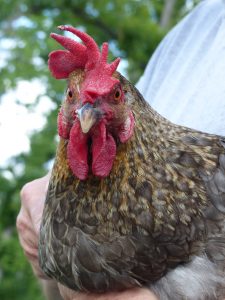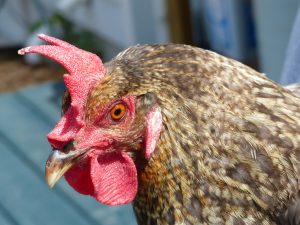If chickens sometimes act in quirky ways, it may be because of their vision.
It’s easy for people to assume that animals see things the way we do, but that’s not the case. Animal vision varies greatly. Like most birds, chickens see the world differently than their human caretakers.
Anyone who has filled an empty bird feeder is often surprised to see chickadees, nuthatches, and other wild birds almost immediately flap in for lunch. How do they know delicious seeds are in a feeder that has been empty for several days? Chickens do the same thing. Open the back door with a bucket of table scraps for the hens and they’ll immediately get excited and rush toward the person. How do chickadees and chickens know the banquet is ready?

Well, there are a few reasons. Birds have an amazing ability to detect motion and respond to it faster than humans. They’re ultra-observant, so the second the back door opens, the motion catches a chicken’s attention. A hen or rooster Immediately lets the flock know a treat’s coming. There’s more.
Chicken eyes are truly amazing. They comprise about 10% of its head compared to about 1% on humans. This helps them have exceptionally keen vision in many ways that people can barely imagine. Here are a few amazing chicken vision traits:

- Their vision is tetrachromatic. Like most people they can see red, blue, and green. Unlike humans, they can also see ultraviolet light. So, their color vision is better than ours.
- They can see in a 300-degree arc. Take a look at chicken eyes. They are prominent on either side of their head. Human or owl eyes are on the face. This wide visual arc lets chickens see a predator stalking from a distance behind them while still spotting a tasty seed in front of their beak. As a general rule prey animals, like rabbits and chickens, see in a wide arc but lack good depth perception, while predators, like owls and people, enjoy depth perception yet lack a wide range of sight.
- Each chicken eye is different. The right eye is nearsighted. It focuses perfectly to find the tastiest seeds or bugs while the left eye is farsighted. That’s what helps the bird see both close and distant objects, but it comes at a cost.
- Chicken vision is sort of like wearing bifocals. Focus is great close and distant but there’s a spot, humans might call it “computer distance”, where a chicken’s eyes don’t perfectly focus. That’s partly why they cock their head this way and that to get a good view.
- People can move their eyes without moving their heads, so we can see to the left, right, up, or down. Chicken eyes are more fixed in their heads. If they want to look in a certain direction, they have to move their head.
- Chickens, like turkeys and some other birds, can’t see directly under their heads. If they expose a tasty worm or bug when scratching in leaves or mulch, they can’t see it until they take a step or two backward. Watch your hens next time and see this phenomenon.
- Although chickens can see colors far better than people, they’re nearly blind in the dark. That’s why they seem almost comatose when roosting at night. Chickens know they are night blind so they seek a safe place to sleep before it gets completely dark…….make sure the coop is raccoon proof and the pop hole door is closed at sunset!
- Baby chicks enjoy good vision almost as soon as they hatch but their eyes reach full potential when they’re only about 48 hours old. That’s why they can easily find food and water when they are just tiny babies.
- Chickens are attracted to the color red. That can be good or bad. Often chick feeders are red to lure babies to eat. However, if a hen suffers an injury and red blood shows, her flock mates will peck at the wound, often making it worse.
- Chickens have a nictitating membrane, a clear extra eyelid. It protects the eyes when they takes a soothing dust bath, yet still allows the birds to spot a stalking predator.
It would be fun to be able to spend an hour or two seeing the world as a chicken or chickadee does. That world would look different from what we see.